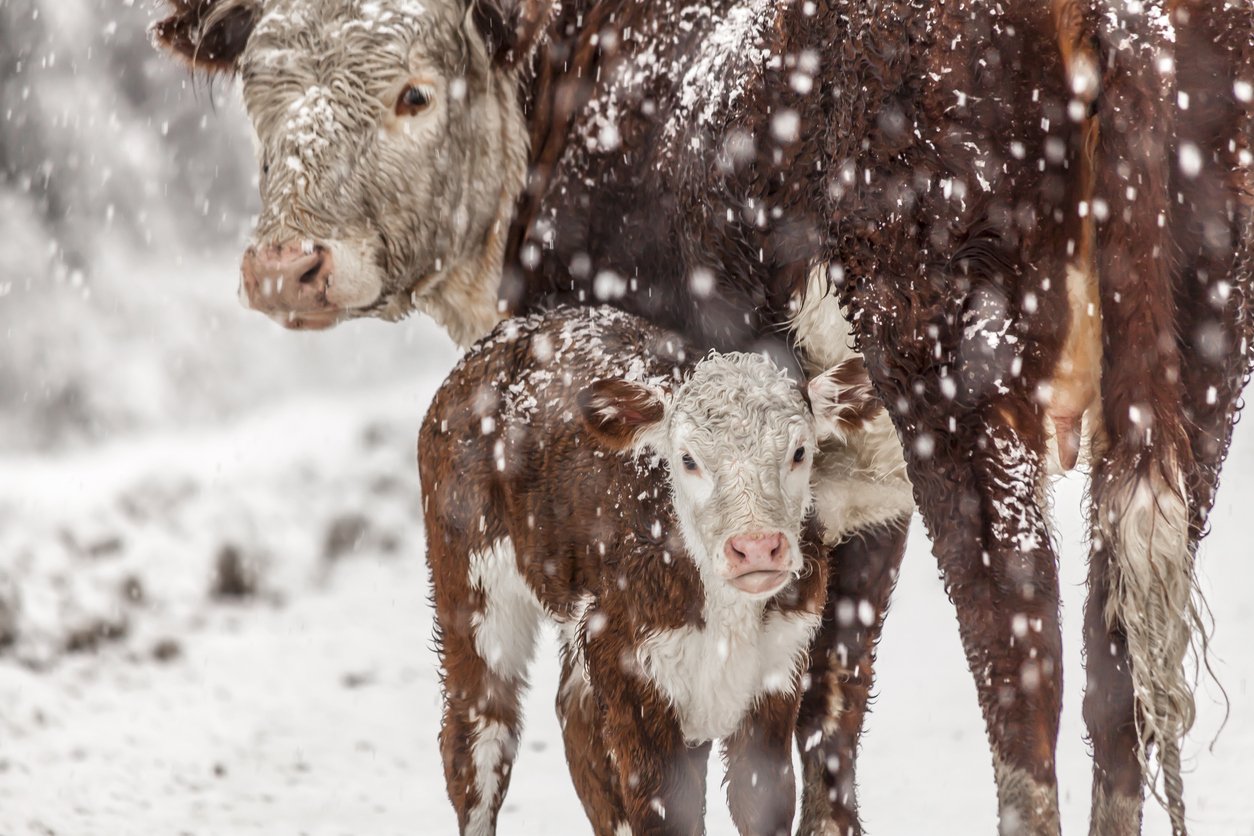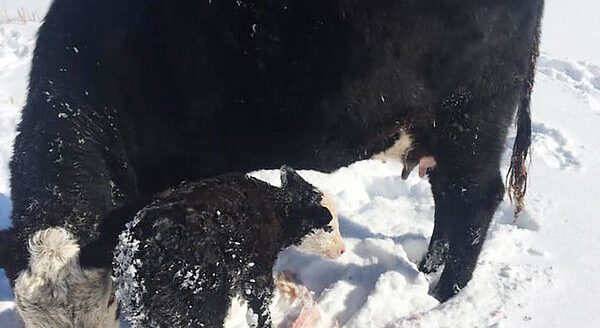Severe wind and cold can cause significant problems for livestock and their owners. Evidence of such problems―the blizzard that struck South Dakota on October 4-5 of 2013. The wind, snow, and cold resulted in major cattle loss. The storm caught many by surprise and the loss was estimated to be approximately 5% of the region’s cattle herd. As an example in Colorado, the blizzard of 2006-2007 caused damage to livestock herds as well as buildings and fences.
What to Expect
- Snow will drift when wind is present.
- Drifting snow can cause damage to fences and buildings.
- Water sources and stock tanks can become damaged or compromised.
- Accumulations of snow can prevent vehicle access to feed or animals.
- Accumulations of snow can bury or trap cattle, especially young animals, and prevent them from reaching shelter or feed.
- Blowing wind and snow and create far more cold stress on animals than just the cold temperatures alone.
- Snow will cause winter range or pasture to become inaccessible for grazing and more difficult to navigate as snow accumulates.
- Ice storms will make pasture or winter range forage inaccessible, more so than snow alone.
- If present, rangeland shrubs may be more accessible for livestock and be higher in protein than grasses.
- Extremities that become wet or are normally damp are particularly subject to frostbite and freezing during sub-zero weather. Livestock may lose or have damaged ears and/or tails.
- Male livestock may suffer cold damage to reproductive organs, which can impair fertility or the animal’s ability to breed.
Shelter
- Before or immediately at the onset of a blizzard or ice storm, move animals to feed and shelter promptly.
- In short duration and small snow storms, landscape topographic features such as ravines, canyons, draws, and windbreaks may be sufficient protection from elements for livestock
- In larger snow storms and longer duration storms, landscape topographic features such as ravines, canyons, draws, and windbreaks may become inundated by snow and trap livestock.
- Young/smaller animals are at greater risk of becoming buried by snow.
- Young/smaller animals are more at risk to cold temperatures.
- Shelters, sheds, or windbreaks are necessary to protect livestock from winter storms.
- Cold temperatures without wind are usually not enough to affect the performance of animals receiving full feed.
- Wind alone can cause the same effect on animals as exposure to a sudden drop in temperature.
- A 20 mph wind is roughly equivalent to a 30° F drop in temperature.
- Under extreme winter storm conditions, simple shelters alone will not be 100% effective in protecting livestock.
- Always plan on snow being accompanied by wind when planning your livestock protective areas.
- Windbreaks that are taller and more dense (have less openings) are more effective than other types of windbreaks. Windbreaks can be manmade or natural (trees).
- Trees that have no leaves during winter are relatively ineffective windbreaks. Evergreen trees such as fir, pine, and juniper are much effective types of trees for windbreaks.
- Snow fences can be a good compromise or substitute for tree windbreaks in some situations. They can also be used in addition to solid fences or tree windbreaks.
- If a porous fence is used, 80% density will offer effective wind protection.
- Plan and know where snow will drift under different wind conditions so that you can make appropriate plans of how to clear gates, shelter openings, barn doors, and roads when snow begins to accumulate.
- Low ceiling sheds with an open front often provide excellent shelters for livestock. Open front sheds should have slot openings located along the eaves of the back of the shelter. Slot openings will allow enough ventilation and airflow through the shed to prevent snow from swirling and accumulating in abundance in front of the shed. Slot size along the eave should be 1-2 inches in size for every 10 feet of building width. Ridge vents are recommended.
- Do not attach windbreak fences directly to the front corner of an open-front shed. Attach a separate short fence to the building. Start the longer fence behind the short fence and shed to keep the snow away from the building.
- If making a long open-front shed, divide them into 20 to 40 feet sections with divider walls to reduce drafts and possible snow buildups.
- Locate shelters so that adjacent buildings, trees, or topography will not deflect wind and snow into or in front of the shed.
- Indoor shelters that are tightly closed may cause a lack of oxygen for livestock, resulting in suffocation.
- Some shed-type shelters may overcrowd and overheat livestock, causing or exacerbating respiratory disorders.
Feed
- Having abundant and accessible feed will help animals maintain body temperature and survive cold temperatures.
- Livestock need extra feed in severe and prolonged cold weather in order to keep up body heat and maintain body condition.
- As wind and the wind chill factor increases, abundant feed alone will not be enough to keep animals warm.
- Make sure stored winter feed is of good nutrient quality for the type of livestock you are feeding.
- Make sure you have enough stored winter feed to meet the demands of your livestock for the winter, with plenty to last you in case of prolonged winter storms.
- If a storm lasts for more than 2 days, emergency feeding methods may be required. Pelleted cake or cake concentrates are examples of emergency feeds.
- Be prepared if cold weather or power outages cause mechanized feeders to become inoperable.
Water
- Regularly check water tanks.
- Make sure water is clean, free of ice, and in adequate supply.
- Make sure you have portable watering equipment or a way to maintain water for your livestock in case of extreme cold and ice.
- If feasible, use heaters in water tanks to provide livestock with adequate water.
Extra Care
- Make sure your insurance policies adequately protect you in case you suffer losses due to extreme winter weather.
- Make sure you have tools, rope, blankets, lights, and a portable generator with extension cords and fuel ready to use in case of emergency.
- Make sure tractors and vehicles are maintained and protected so that they will be ready to use in extreme cold weather and snow/ice.
- Make sure you have bedding available to be deployed so that you can create a warm and protected place to keep livestock off ice and mud so that they can stay dry.
- Care for young animals first, since they are more vulnerable than larger animals.
- Livestock will often move away from the force of an oncoming storm, unless they are moving toward shelter that is well known to them.
- Older animals may follow or try to stay near young animals that are being moved or treated, due to herd and/or maternal instinct.
- Extreme conditions during blizzards can cause both livestock and humans to become panicked or confused.
- Animal survival instincts may affect your ability to herd or move livestock during extreme conditions.
- Livestock may avoid traveling directly into the force of an oncoming storm (wind, snow, sleet, etc…).
- Livestock are likely to avoid areas or begin to panic where they have poor footing.
- Livestock may resist or be hesitant to leave even limited shelter behind during storm conditions.
- Make sure animals are in good body condition and vaccinated. Livestock that are larger and in good body condition can handle winter weather and extreme conditions better than smaller or weaker animals.
If you have questions about how to care for you livestock in severe winter weather or how to prepare, contact your local Extension office. More information can be found at http://extension.colostate.edu.
Information Sources:




